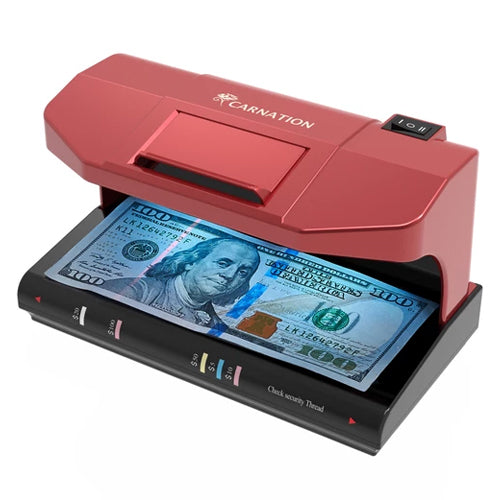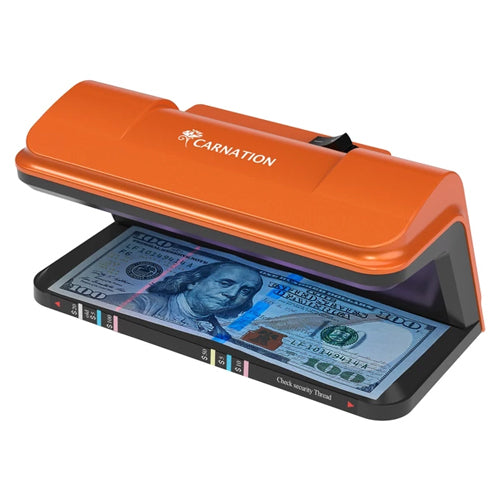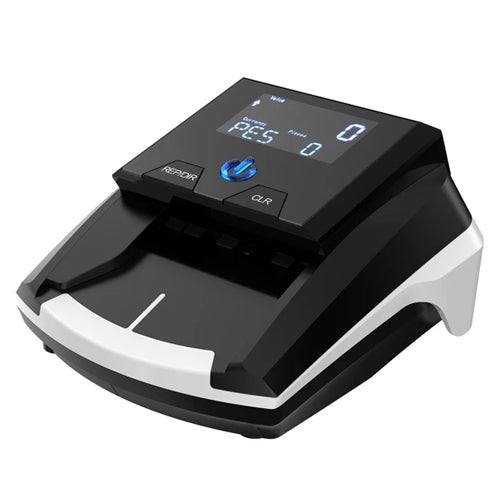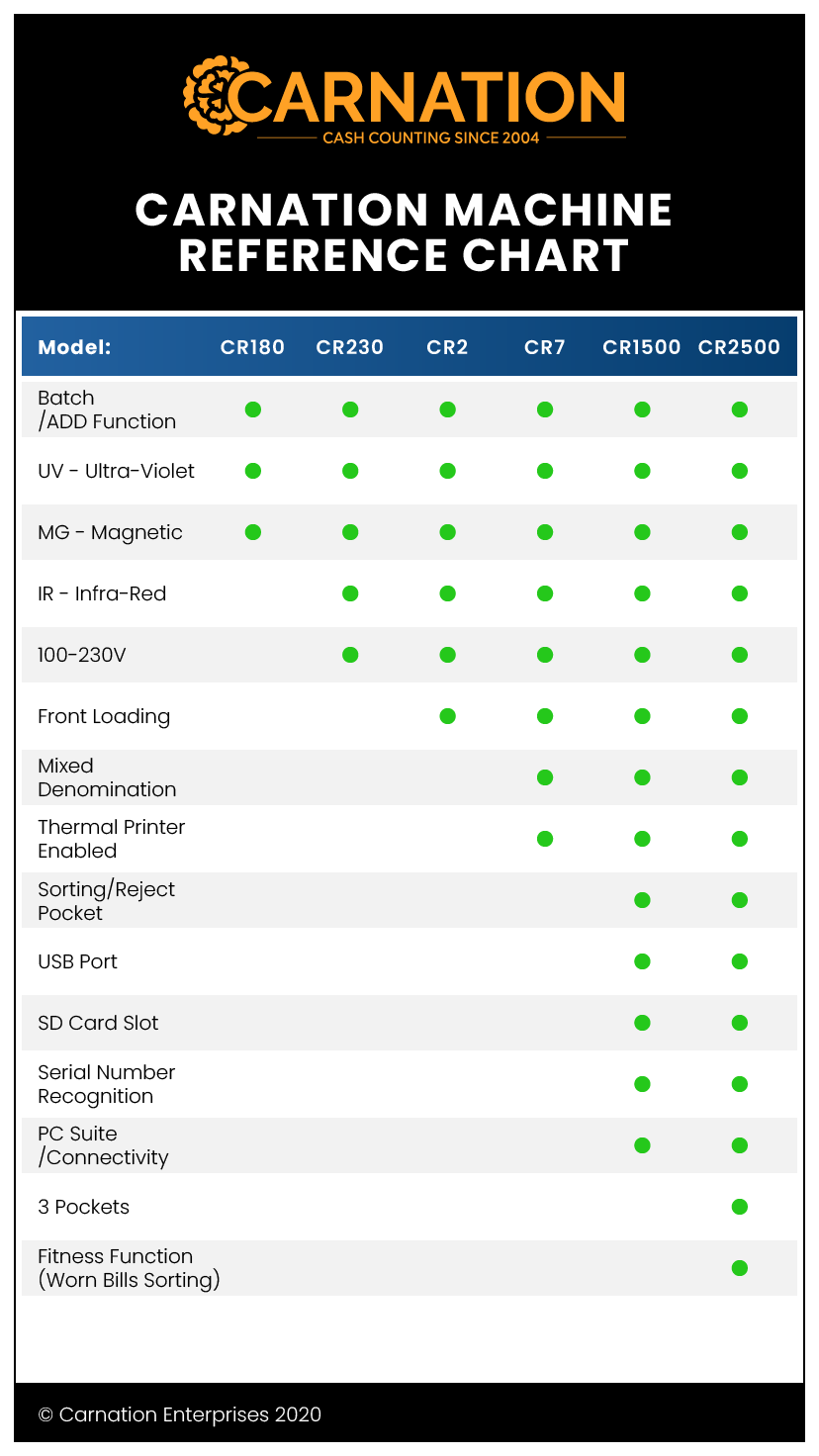Su carrito actualmente está vacío.

Cómo saber si una factura es falsa
Detectar dinero falso
¿Por qué la práctica de falsificar dinero es un tema tan candente en este país? Bueno, créalo o no; Los billetes de dólar de los Estados Unidos tienen una gran cantidad de características de seguridad de alta tecnología, lo que hace que el dólar sea una de las monedas más avanzadas del mundo. Estados Unidos también tiene una agencia gubernamental dedicada, el Servicio Secreto, que se especializa en combatir la falsificación. Sin embargo, toda esta seguridad tiene un precio: ¡es caro imprimir dólares estadounidenses! Entonces, ¿por qué un enfoque tan intenso en la lucha contra las facturas falsas? Las raíces del problema de la falsificación se remontan a mucho tiempo atrás. Los dólares falsos han estado en circulación en los Estados Unidos desde los días del dominio colonial, seguidos de un enorme aumento en la falsificación durante la Guerra Civil. Por lo tanto, la historia ha convertido la falsificación en un tema crítico en los Estados Unidos.
Cómo detectar dinero falso: en 7 pasos
Ahora, veamos cómo detectar una factura real o falsa. Aquí hay un mnemotécnico fácil: hay siete billetes estadounidenses ($ 1, $ 2, $ 5, $ 10, $ 20, $ 50, $ 100) y siete pasos para autenticarlos. Si olvida cuántos pasos, cuente mentalmente el número de billetes estadounidenses de diferente denominación.
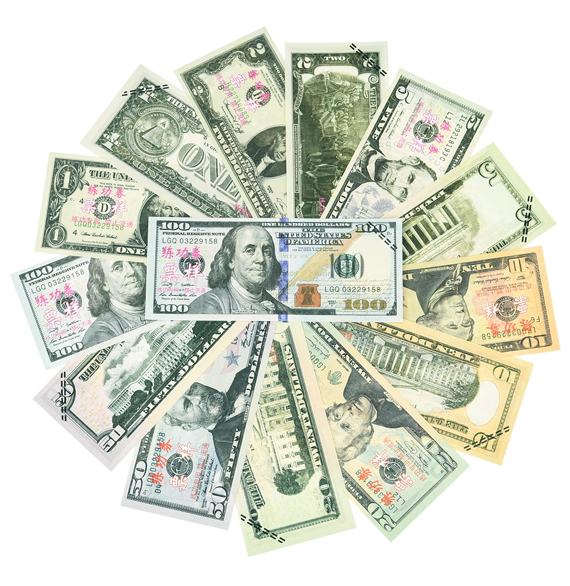
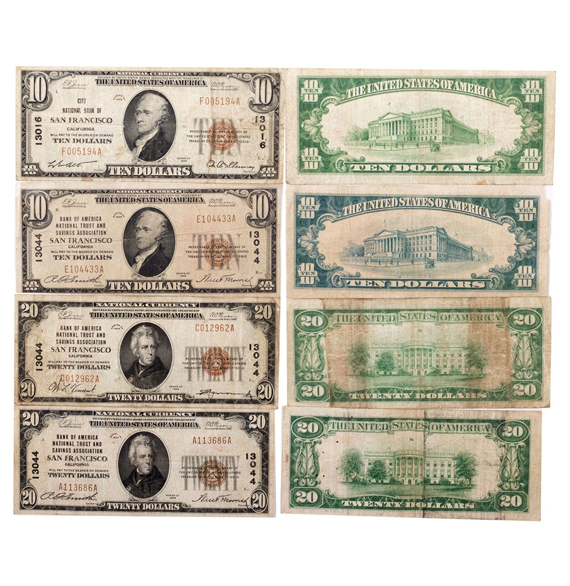


Paso 1: las características físicas
Entonces, comencemos con las pruebas más simples y trabajemos hacia arriba.
El tamaño y el peso del papel moneda estadounidense están estrictamente controlados. Los siete billetes estadounidenses miden 2,61 pulgadas de ancho por 6,14 pulgadas de largo y 0,0042 pulgadas de grosor, y cada uno pesa 1 gramo. Apile todos los billetes que tiene y vea si alguno es del tamaño incorrecto, aunque sea solo un poco.
El "papel" (no es realmente papel) del que está hecho el billete es una mezcla especial de 75% algodón y 25% lino. Este material tiene una sensación distintiva, según Independent Banker. Tus dedos son extremadamente sensibles al grosor y la textura. Frote rápidamente cada billete entre los dedos. Si no se siente bien, déjelo a un lado para verificarlo más. Nueve de cada diez veces, sus dedos serán detectores falsos precisos.
También puede colocar cada billete junto a un billete real del mismo monto en dólares y ver si algo no coincide. Sin embargo, esto suele llevar demasiado tiempo y no es muy eficaz. Si nota bordes, impresiones o texto significativamente borrosos, esto debería ser una señal de alerta automática. Los billetes auténticos son extremadamente detallados, hechos con planchas de impresión troqueladas que son capaces de crear líneas impresionantemente finas. Las impresoras láser y de inyección de tinta rara vez tienen el mismo nivel de detalle. Mire de cerca, especialmente en los bordes, para ver si hay partes borrosas en el billete.
Aquí hay un consejo que puede acelerar todo el proceso. Hay algunas notas que puedes ignorar y otras que deberías revisar cuidadosamente. Para hacerlo aún más rápido, solo hay dos que vale la pena verificar: el billete de $ 100 y el billete de $ 20.
El billete de $ 100 es el que se falsifica con más frecuencia. Tiende a ser el objetivo de los sindicatos extranjeros y las "fábricas de dinero" en ciertos países. Sorprendentemente, los billetes falsos de 100 dólares no son los billetes falsos más comunes que se encuentran aquí dentro de los EE. UU. De acuerdo con Cómo detectar un billete de $ 20 falsificado de Fraud Fighter, el billete de $ 20 es la elección popular de los falsificadores en los Estados Unidos continentales. El Jackson es popular entre los delincuentes domésticos porque es un proyecto de ley común que se distribuye en los cajeros automáticos y, por lo general, no se examina con el grado de escrutinio de los billetes más grandes, dicen los funcionarios del Servicio Secreto. Por lo tanto, debería examinar los billetes de $ 100 y $ 20 con más cuidado. Los otros billetes rara vez son falsificados, y la angustia por comprobar uno o dos billetes falsos de $ 1, $ 2 o $ 5 no vale la pena el tiempo y el esfuerzo, a menos que tenga motivos para creer que se le ha entregado una cantidad significativa de ellos.
Suponiendo que ha encontrado una factura o facturas que no "se sienten bien", ¿qué debe hacer a continuación? Si tiene más de una de estas facturas sospechosas y son de la misma denominación, verifique que los números de serie sean idénticos. Esto al menos filtrará a los falsificadores aficionados y a los niños que usan fotocopiadoras en color. La facilidad con la que las personas pueden comprar software de edición de fotografías o buscar cómo hacer facturas malas ha agregado a los adolescentes a la demografía de los delincuentes avanzados.
A menudo, solo tendrá una factura sospechosa en el lote. Luego, tenemos que utilizar una de las funciones anti-falsificación más sofisticadas integradas en el papel moneda estadounidense. Hay siete funciones de seguridad inteligentes integradas en las facturas estadounidenses. Es comprensible que el billete de 100 dólares tenga la mayor seguridad, ya que es el billete de mayor valor y genera las mayores ganancias cuando se falsifica.
Para divagar por un momento, ¿qué beneficio crees que obtienen los falsificadores con un centenar falso? En Perú, el precio de venta promedio de 100 dólares falsos a granel, es decir, el precio "mayorista", es de 20 dólares. El pegamento necesario por billete es de 50 centavos, el papel se puede comprar a granel por $ 10 a $ 15 por pila. Incluyendo la mano de obra, el costo total es de entre $ 3 y $ 5; eso es una ganancia de al menos $ 15 por billete falso de $ 100. A un costo de "fabricación" de cinco dólares por factura, es un margen de beneficio del 300%. No es un mal negocio, si puede salirse con la suya.
De la moneda falsificada incautada en los Estados Unidos el año pasado, el 61% se fabricó mediante impresión digital, y el resto de la moneda falsificada se fabricó con impresión tradicional o “offset”. La falsificación digital está superando a la impresión tradicional porque las impresoras actuales de alto rendimiento y bajo costo ofrecen alta resolución y una mejor coincidencia de color de la moneda copiada. Esta tendencia ha cambiado quién produce malas facturas.
El billete de $ 100 fue rediseñado en 2013. El cambio tardó en llegar, debido a una falla de fabricación en 2010 con el pliegue del billete, pero el resultado final fue el billete más complejo jamás realizado. El nuevo billete de $ 100 tiene las características de protección más avanzadas de los siete billetes de EE. UU. Ahora es un proyecto de ley extraordinariamente sofisticado.
entre todos los billetes de papel moneda del mundo.
Como todos los demás billetes más pequeños, tienen varios subconjuntos de las características de seguridad del nuevo billete de $ 100. Primero nos ocuparemos de cómo falsificar un billete de $ 100.

Paso 2: La marca de agua del retrato de Bills
Para aplicar los cheques más sofisticados por $ 100 falsos, veamos el más fácil de verificar, la marca de agua vertical. Puede consultar las descripciones completas de estas funciones en el sitio web de la Reserva Federal de EE. UU .: www.UScurrency.gov. La imagen de la marca de agua se debe a que la Casa de la Moneda de EE. UU. Utiliza papel de diferente grosor, y las áreas claras son el resultado de un papel más delgado. Una marca de agua es una característica de seguridad excelente, ya que es muy poco probable que un falsificador fabrique su propio papel. Las marcas de agua se pueden simular de alguna manera, pero los efectos casi siempre son muy burdos.
Dónde encontrar la marca de agua: hay un contorno tenue de Ben Franklin en el espacio en blanco entre el "100" superior (pequeño) e inferior (grande) impreso en el lado derecho del billete. Es visible desde ambos lados del billete, ya que no está impreso en el billete, sino incrustado en el grosor del papel. Para que sea más fácil de encontrar, busque la marca de agua que se superpone parcialmente con el sello del Tesoro (vea la ilustración a continuación). Debe sostener el billete a una luz brillante y mirar con cuidado.

Paso 3: la franja de seguridad
Security Strip es una tira incrustada delgada y tenue que se extiende verticalmente a través del billete de arriba a abajo, justo a la izquierda de Ben Franklin en el billete de $ 100. El hilo debe ser visible desde ambos lados del billete.
El hilo en un billete de $ 100 se ilumina de color rosa cuando se ilumina con luz ultravioleta (UV). Está presente en la mayoría de los billetes de EE. UU. (Excluyendo los billetes de $ 2 y $ 1 de pequeña denominación), antiguos y nuevos, y es la principal característica de seguridad utilizada por Contadores de dinero y Comprobadores de facturas para identificar falsificaciones.


Paso 4: la microimpresión
A continuación, una característica de seguridad realmente sofisticada, difícil de verificar pero aún más difícil de falsificar. Los nuevos $ 100 contienen microimpresión, letras muy pequeñas en varios lugares extraños esparcidos sobre el billete. Mire con atención (será necesaria una ampliación) para ver el texto microimpreso en los siguientes lugares:
- "LOS ESTADOS UNIDOS DE AMÉRICA" impreso en el cuello de la chaqueta de Ben Franklin, justo debajo del pañuelo.
- “USA 100” impreso (en azul) alrededor del espacio en blanco que contiene la marca de agua de Ben Franklin (que localizamos en un paso anterior).
- "USA USA USA ..." está impreso en la parte inferior del retrato de Ben donde se encuentra con el borde del billete.
- A lo largo de la pluma dorada de los Padres Fundadores está la letra diminuta de "CIEN ESTADOS UNIDOS". Esto se encuentra en el lado derecho del contorno de la pluma.
- En los bordes exteriores del billete, hay pequeños "100" en los bordes izquierdo y derecho del billete. Estos están incrustados en los "hormigueros" del patrón del borde. Tienes que ser "guapo", porque son difíciles de ver.

Paso 5: la tinta que cambia de color
La quinta característica de seguridad de alta tecnología es la tinta que cambia de color. Las partes del billete se sobreimprimen con una capa más gruesa de una tinta especial que tiene diferentes colores según el ángulo en el que se mire.
Para ver esto, incline el billete y mire la campana en el "Tintero" y el número grande "100" en la esquina inferior derecha del anverso del billete. Deben cambiar de color de cobre a verde a medida que se mueve la nota. El gran "100" es particularmente fácil de ver y el cambio es dramático. Es sorprendente ver la marcada diferencia de color. Una característica divertida y una vez más difícil de falsificar.

Paso 6: la impresión en relieve
Mueva el dedo hacia arriba y hacia abajo del hombro derecho de Ben Franklin (lado izquierdo del billete). Debe sentirse elevado y áspero al tacto. Esto se debe a la impresión en huecograbado empotrada.
La impresión en relieve de tecnología anterior se puede sentir en el resto del billete de $ 100. Por ejemplo, el número de serie y el Sello del Tesoro, pero la antigua impresión en relieve no es tan pronunciada como la nueva alta tecnología. Para detectar la impresión en relieve más antigua, puede compararla con la sensación de un billete genuino que sabe que está bien.


Paso 7: la cinta de seguridad 3D
Hemos guardado lo mejor para el final, la cinta de seguridad 3D, porque esta función también es la más complicada de comprobar. La cinta de seguridad 3D es la franja vertical azul brillante, de unos 6 mm de ancho, en el centro de los $ 100 a la derecha del retrato de Ben Franklin. Esta franja también se llama “hilo” porque no está impresa sobre la parte superior del billete, sino que se “enhebra” a través del papel, sobre la capa superior de papel y debajo de esta capa superior.
Sumérjase en los misterios más profundos de la cinta de seguridad 3D. En realidad, es un holograma y es totalmente mágico. Como se indica en La tecnología 3D de Snapily le da un cambio de imagen al dinero de EE. UU., Se compone de cientos de miles de "microlentes" que crean un efecto de alta tecnología.
Mueva el billete mientras se concentra en la franja azul rota en el centro. Verá tres filas de "100" cuando mire el billete con el borde izquierdo hacia usted. Estos 100 se mueven de una manera inusual.
Asegúrese de tener una buena iluminación fuerte. Cuando gira la nota alrededor de su centro vertical (llamado "guiñada" en un avión, como si el billete estuviera tratando de batir sus alas), los 100 se mueven de izquierda a derecha, no hacia arriba y hacia abajo, algo inesperado y muy extraño. Ahora, dale la vuelta al billete para que el borde ancho quede al frente.
Gire el billete hacia adelante y hacia atrás alrededor de su eje horizontal (llamado "rodar" en aviones) y ahora los "100" se moverán de lado a lado. Guau. El truco es que los "100" se mueven hacia adelante y hacia atrás a lo largo del eje opuesto al eje a lo largo del cual se gira el billete.
Se pone mejor. Si examina los "100" con mucho cuidado mientras guiña y gira el billete, debería ver que los "100" se convierten en "campanas". Estas "campanas" son del mismo tipo que la "campana de la libertad" que cambia de color en el tintero. (Encontré que los “100” son más fáciles de ver). Las campanas deben moverse de la misma manera no intuitiva que los “100” cuando se gira o se inclina el billete.
Puede consultar las descripciones completas de todas estas funciones en el sitio web de moneda estadounidense. El sitio también muestra algunas imágenes muy útiles de cómo gira y gira los billetes para que las características de seguridad sean posibles de ver.
Detectores de dinero falso
Solo algunas de estas funciones avanzadas son verificadas automáticamente por contadores de dinero electrónicos y detectores de billetes falsos. La mayoría de estas máquinas usan detección de tinta UV y magnética, sobre todo porque detectar solo estos dos es rápido y utiliza sensores económicos. Los contadores de dinero más avanzados utilizarán el escaneo de imágenes en color y el reconocimiento de funciones, pero incluso estas máquinas avanzadas no pueden leer hologramas e impresiones en relieve. Los sentidos humanos siguen siendo los mejores, por ahora.
This discussion has so far focused on the new $100 note because it is on the top of the pile, security-wise. Let’s switch to discussing the other bills – the fifty, twenty, ten, five, two, and one dollar. As they go down in value, the security features become fewer. None of these bills has the full set of advanced features contained in the new hundred dollar bill. From an anti-counterfeiting point of view, once you know how to check for fake hundreds, you know how check all the rest. As pointed out earlier, the $20 is the object of most of the counterfeiting activity within continental US, so we focus on the $20 more than the other bills.
How to spot counterfeit money in smaller bills
The $50 bill was last updated in 2004 and has not been changed since. The $20 bill was last redesigned in 2003. We will deal with these two notes together, as they have the same feature set. As discussed earlier, the $20 should be checked carefully. The main difference in the $20/$50 bill security feature set, is the absence of the “magic” 3D Security Ribbon. The precise size and weight, watermark, security strip, micro-printing, color-shifting ink, and raised printing are all present in the $20 and $50 bills, with only slight differences to the $100 note, as follows:
The UV-sensitive Security Stripe in the $50 is located to the right of the portrait, not the left as in the $100 bill. On the $20 bill and $5 it is still on the left. This extra security measure was originally added to provide a quick way for bar owners (one of the businesses most commonly targeted to dispose of fake 20 dollar bills) to check the legitimacy of a bill.
If the $20 bill is held up to an ultraviolet light the security stripe glows green, if it is authentic! Hold the note to light to see the stripe (security thread) to the left of Andrew Jackson’s portrait. It reads USA TWENTY and includes a small flag. The thread is visible from the front and back of the note and glows green under ultraviolet light


Here are the location and colors of the security stripes on different denomination bills and how to detect:
- $5 – Right side. Glows blue under UV light and a fake 5 dollar bill will not glow.
- $10 – Right side. Glows orange under UV light and a fake 10 dollar bill will not glow.
- $20 – Far left hand side. Glows green under UV light and a fake 20 dollar bill will not glow
- $50 – Right side near the middle. Glows yellow Under UV light and a fake 50 dollar bill will not glow.
- $100 – On left side. Glows pink under UV light and a fake 100 dollar bill will now glow.
How to tell if money is fake using red and blue threads
If you take a close look at an authentic bill, you will see that there are small red and blue threads woven in and out the fabric of the bill. Printers try to reproduce this effect by printing red and blue lines onto the bill in a similar pattern. A close look will often reveal that such printing is merely on the surface and not in the paper. It’s best to compare with a real $20 to be sure.

An extra thing you could check on a $20 bill is that the serial number correctly matches the “series year” printed on the bill. The first letter of the serial number for a bill should correspond to the year of the Series Block (see picture for location) as below:
- E = Series 2004
- G = Series 2004A
- I = Series 2006
- J = Series 2009
- L = Series 2009A
The new series $50 also has color-shifting ink on the “50” in the lower right-hand corner.
The $10 bill was updated in 2006 and also has the same feature set as $50
The $5 bill was updated in 2008. It has the “standard” security feature set of the $50 but without the color-shifting ink.
The $1 bill was updated in 1963 and has only raised printing.
And the less-common $2 was last updated in 1976 and has only the raised printing.
Lastly, there is a relatively new, extremely simple, way to detect dud dollars, and that is using a Counterfeit Pen or, more accurately, a counterfeit-detection pen. This looks like a fat permanent marker but with a key difference. When you mark a bill, let’s say a $20 note, with the pen in a genuine $20 the marking will show up bright yellow. On a fake dollar bill (or on ordinary paper), the marking will slowly turn black. Don’t worry, the mark you make on a good bill is not permanent. It quickly evaporates and leaves no trace. However, on a fake bill the black mark will remain, so mark your bills with a large “X” and the fakes will be easy to separate!
How does a counterfeit pen work?
The pen contains a tincture (solution) of iodine as ink that reacts with the starch in wood-based paper to create a black stain. As we discussed in Step 1, the “paper” that US bills are made is a blend of 75% cotton and 25% linen. There is no starch at all in a genuine bill. When the iodine solution is applied to the cotton-and-linen-based paper used in real bills, no discoloration occurs. You can read more on How Stuff Works’ How does a counterfeit detector pen work?
A good quality counterfeit-detection pen will also have a UV light source, usually built into the lid. When you press a button on the clip of the lid, an UV LED switches on. Shine the UV spot on a good hundred, at the left of Ben Franklin’s portrait, and you will see the UV security stripe light up in pink. Also, a genuine bill will absorb UV light while a dud will reflect UV.
Place a piece of ordinary paper overlapping the bill under test and move the UV light-spot back and forth from the paper to the bill. For a real $100, the UV spot will be much brighter on the paper than on the bill. This check will work for all the other bills too, with the UV stripe glowing in the specific color for each denomination, as listed in the table above under “UV-sensitive Security Stripe”.
A pen does have its limitations though. Most commercial paper is made from wood pulp and is brown until it is bleached and starched. Sophisticated counterfeiters will not use paper that contains starch. Instead they will buy paper that is made from cotton/linen fibers like those used in legitimate US bills. While this is not an available option to the average counterfeiter, governments unfriendly to the United States, and sophisticated large-scale operators do have ways to access starch-free paper.

The pen is inexpensive, small, easy to use, and will provide quick results. It is probably a good investment if you handle large amounts of cash every day. However, don’t rely on it solely. Use one or more of the Seven Steps as well to have more confidence that your bills are good.
Where the problem started – and why you should check carefully for counterfeit dollars
The first large-scale, deliberate counterfeiting started as the colonies began their march toward independence. The British experimented with pumping in fake currency in volume to weaken the economy and foil the attempts to achieve independence. This was the first time counterfeiting had been used as a weapon of war.
Until the 1780s, paper money had always been backed by gold. This made counterfeiting less popular. The first experiment with “pure paper” money was driven by the exigencies of war. The Continental paper money issued during the Revolutionary War (1775-1783) was not backed by a physical asset such as gold or silver. It quickly lost value to zero shortly after the war, simply because people stopped accepting it as payment for goods and services.
The origin of the saying “not worth a Continental”, and the phrase “I don’t give a Continental” does not mean what you might think.Continental currency was soon replaced by the adoption of a stronger currency, the original U.S dollar, but in many different forms. There were eventually no less than six different types of dollar bills in circulation. All these paper currencies, however, were convertible to gold “on demand”.
The next experiment in relaxing the gold-backing for paper money was again driven by the exigencies of war, but this time it was the Civil War of 1861–1865. Under President Lincoln, a paper dollar not exchangeable for gold was issued as “legal tender” in 1862 as an emergency war measure. Some people feared, with good reason, that it would create a financial calamity. However, thousands of troops had to be paid and equipped; weapons, everything from bullets to cannons to ironclad warships, had to be built. The fledgling Union did not have the gold to finance this. They went right ahead and printed dollars anyway, initially some $400 million worth of them. If every one of the new dollar notes had been presented for conversion to gold, the Union government would have been broke many times over.
The new Federal Dollars were printed in green ink on the back, and became known as “greenbacks” - a derogatory term at the time. One version of origin of the name is that people said the money had no backing other than the green ink on the back. Also called “funny money”’, the value of these notes gyrated wildly with military wins and losses, inflation soared as high as 75%, and in 1863 just before the Gettysburg Address, a $100 greenback was worth only $35 in gold. To read more on the Civil War and Greenbacks, check out The Gold Standard Now.
The ironic thing about greenbacks is that they are actually totally un-backed.
By some unprecedented miracle, the greenback dollar survived, and the notion of a paper currency with an illusory value began to take root and become acceptable to the public.
In July of 1929, the US Fed decided to replace the physically large notes circulating with smaller notes, closer to the dollar note size now used. Originally intended to save on paper cost, the change unexpectedly created another revolution in US paper money. Just three months after the changeover, the stock market crashed completely, and the Great Depression began. The great crash was not unrelated to the fact that the economy had been running on un-backed dollars since the Civil War.
The six types of dollar currency then circulating were Gold Certificates, Silver Certificates, National Bank notes, United States notes, Federal Reserve notes, and Federal Reserve Bank notes. Each system had its own denominations. There was an unmanageable hodgepodge of over 50 different dollar bills types and values. A counterfeiter dream.
Soon after the Civil War, it was estimated that, of the nation's entire currency in circulation, no less than one third to one half was counterfeit. Four years of intense combat had left 620,000 to 750,000 people dead and much of the country’s infrastructure destroyed, especially the transportation systems, railroads, mills and houses. Counterfeit money posed a major threat to the economy, and financial disaster loomed. There was a very strong reaction by the Federal Government, the effects of which are felt to this day. Nowadays even though the actual number of fake bills in circulation in the USA is very small, according to the US Treasury, the time and effort, not to mention money, spent on combating fake dollars is still disproportionately large.
In 1985, an ad-hoc department impressively named the “Secret Service” was founded, with reducing counterfeiting as its primary mission. While this helped tamp down massive counterfeiting, there were some notable exceptions, for example:


The Peru 2001 CB-B2 series $100 bill incident
• In 2005, Peruvian Banks ceased to accept $100 bills, the 2001 series CB-B2, due to a detection of a series of counterfeit bills in Peruvian circulation. The Peruvian media reported that the notes were so well made that they were "perfect fakes". According to How to Peru’s Fake Money in Peru, the differences between them and genuine bills were reportedly minuscule and difficult to detect. According to Peruvian news reports, a printing plate from the Bureau of Engraving and Printing was stolen by a criminal, with possible links to al-Qaeda, and the plate was likely used to produce the counterfeit bills
made in North Korea or not?
• Very high quality counterfeit one-hundred-dollar bills that became known as “superdollars” were some of the most widely distributed counterfeit American dollar bills still being produced in 2007. They are said to be made with the highest quality of ink printed on a cotton/linen blend and are designed to recreate the various security features of United States currency. The U.S. Secret Service estimates that $45 million in superdollars have been produced since 1989. They accused North Korea of being the counterfeiter, but evidence for this accusation is lacking. In 2008, McClatchy Newspapers’ article about US Counterfeiting reported that the United States no longer explicitly accused the North Korean government of producing supernotes.
How many counterfeit bills are in circulation today?
The Federal Reserve Bank estimates that less than 0.01% of all U.S. currency in circulation worldwide is counterfeit. That amounts to $85.4 million in forged currency compared to the $8,500 billion real bills circulated throughout this country, according to the U.S. Secret Service. So the chances of finding a counterfeit bill are relatively small; only one fake in 10,000 bills, on average.
The best defense against a future flood of counterfeit currency is an educated and aware public. Tell your friends about the seven steps, and encourage them to download and read this article and other reliable anti-counterfeiting articles. It’s important. Genuine and dependable paper currency is key to the financial security of the United States.
References:
Press, T. A. (2013, October 07). New $100 bill heads to banks Tuesday.
Retrieved March 06,2018, from www.pressherald.com/2013/10/07/new__100_bill_heads_to_banks_tuesday_/
Currency detector - Wikipedia. (n.d.). Retrieved March 6, 2018, from en.wikipedia.org/wiki/Currency_detector
The Proceedings of the Friesian School, Fourth Series. (n.d.). Retrieved March 06, 2018, from www.friesian.com/
Currency-counting machine. (2018, February
28). Retrieved March 06, 2018, from en.wikipedia.org/wiki/Currency-counting_machine
The U.S. Currency Education Program. (n.d.). Retrieved March 06, 2018, from www.uscurrency.gov/
U.S. Department of the Treasury. (n.d.).
Retrieved March 06, 2018, from home.treasury.gov/
Ilao, J.,
Smoker, J., Allen, K., T., Aland, M., D., . . . J. (2018, January 19). How to Detect Counterfeit Money: 8
Ways to Tell If A Bill is Fake. Retrieved March 06, 2018, from fitsmallbusiness.com/how-to-detect-counterfeit-money/


